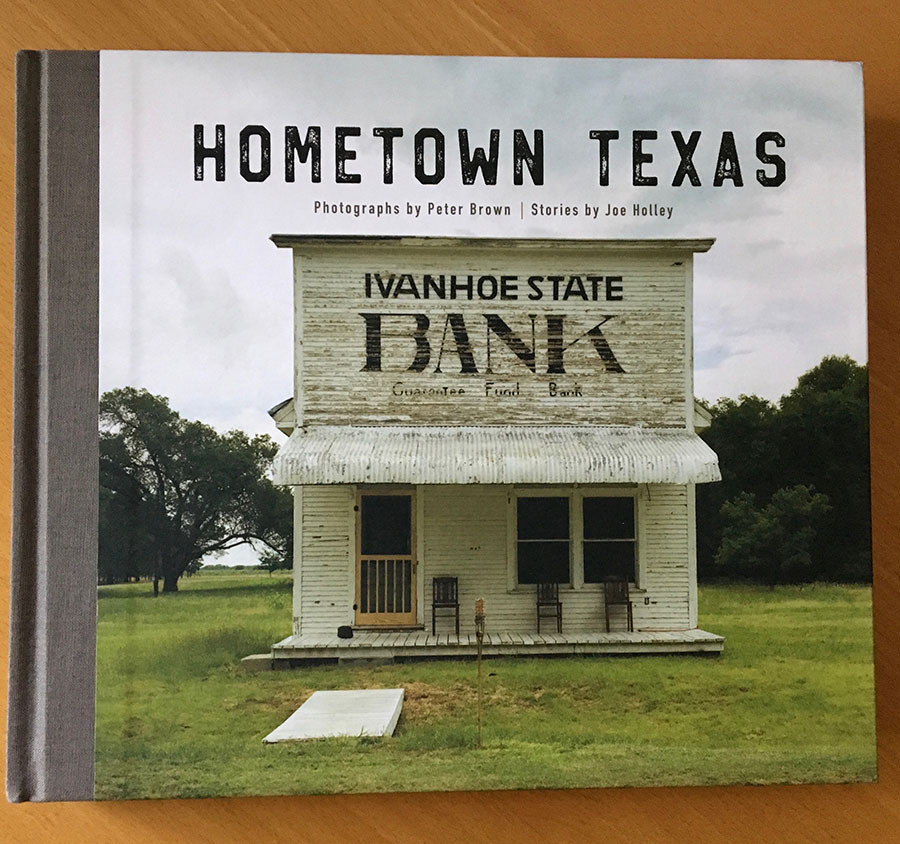
Hometown Texas
258 pages
Maverick Books, Trinity University Press, San Antonio, 2017
From Rice University Magazine, Winter 2018 by Lynn Gosnell
"For three decades, Peter Brown has taught photography classes in Rice's continuing education program, inspiring hundreds of students along the way. For the past quarter century, he has been drqwn to landscapes and small town scenes. In this collection, Brown collaborates with Joe Holley, who writes the "Native Texan" column for the Houston Chronicle, to create a portrait of Texas that ranges widely in subject matter while being devoid of the ususl stereotypes - a Texas far from the bragging crowd. Deviding the state into regions, Brown contributes imagery that creates a visual context for Holley's illuminating essays on rural life. In the book's introduction, Brown writes, "Our collaboration describes the way we feel: That there is much to be seen, heard and appreciated in these little towns. That there are creative and energetic people working with good ideas that they apply locally, and that their stories are worth passing on and celebrating." While the photographs are not intended to illustrate specific essays, imagn and story are perfecttly in sync in their appreciation of a side of the Lone Star State that rarely makes the headlines. Brown's photographss are collected in museums across the country and he is the award-winning author of numerous collections, including "On the Plains, (Norton, 1999) West of Last Chance" (Norton 2008) and "Season of Light" (Rice University Press, 1988).
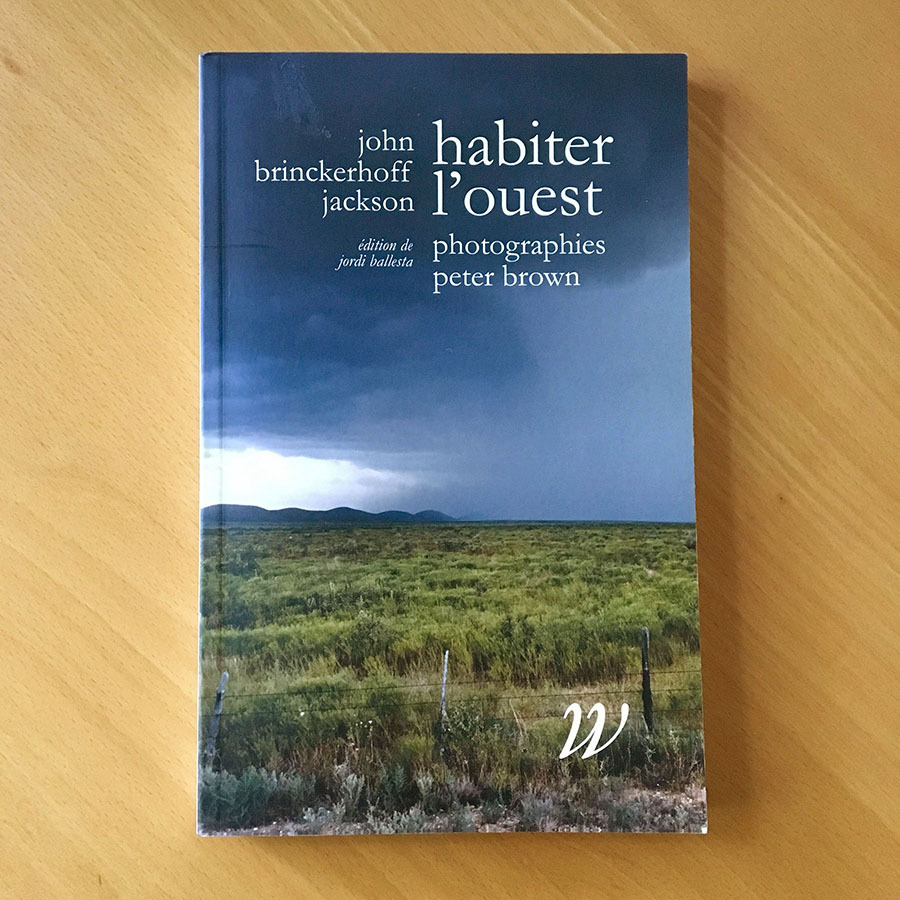
Habiter L'Ouest
95 pages
Éditions Wildproject, Marseille, France, 2016
A book which the cultural geographer J.B. Jackson and I worked on together in the mid to late eighties and early nineties. I'm so happy to have it out in print. Trinity University Press will publish an English language edtion in 2019.
From the publisher:
“Now recognized throughout the world as a leading figure among geographers, photographers and landscape painters, the cultural geographer John Brinckerhoff Jackson and with his photographic collaborator Peter Brown are the authors of a rich new work.
Unpublished in the United States or elsewhere, Habiter L’Ouestcomes from the discovery in Jackson’s archives, by French researcher Jordi Ballesta, a forgotten manuscript. At the crossroads of geography and literature, Habiter L’Ouestis Jackson's most successful narrative, and his only book conceived with a photographer.
In the mid-1980s, J.B. Jackson began a multi-year collaboration with the Houston photographer Peter Brown in an attempt to describe the cultural landscape of the American West -- in particular the High Plains of New Mexico.
Roads, mobile homes, ruins, trucks, barbed wire, wide open spaces, crumbling adobe, vacant Main Streets, cattle, stations, clocks, cars, highways, strips centers: a history of the unstable and fragile contemporary West takes place before our eyes.
In reaction to the romanticism often accorded West, the two tell of and analyze our relationships to the places we inhabit: these intimate and often brutal relationships that carve, in the immensity of this western world, livable portions of time and space. They offer a genealogy of our rural and suburban world.
Habiter L’Ouest teaches us to read the ordinary landscape, to explore the real, lived space where lives take place.”
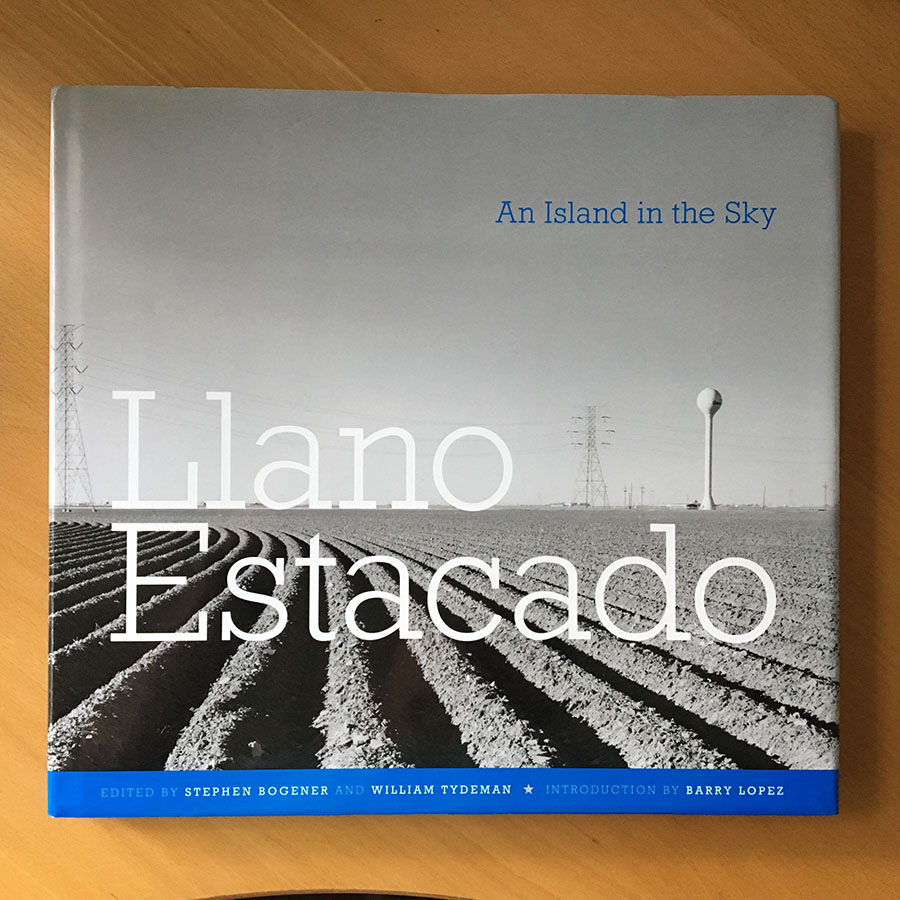
Llano Estacado: An Island in the Sky
178 pages
Texas Tech University Press 2011
A collaboration on the Llano Estacado: the New England sized, mile high, mysterious and beautiful immensity of land that covers the western parts of the Texas Panhandle and the eastern parts of New Mexico. The project was funded by Texas Tech University and the collaboration was with photographers Rick Dingus, Steve Fitch, Andrew John Liccardo, Miguel Gandert and Tony Gleaton. Edited by Stephen Bogener and William Tydeman, introduction by Barry Lopez with contributing essays by, Rick Bass, William Kittredge, Sandra and Jessica Scofield and Annick Smith.
Winner of the Ron Tyler Award from the Texas Historical Society, 2011.
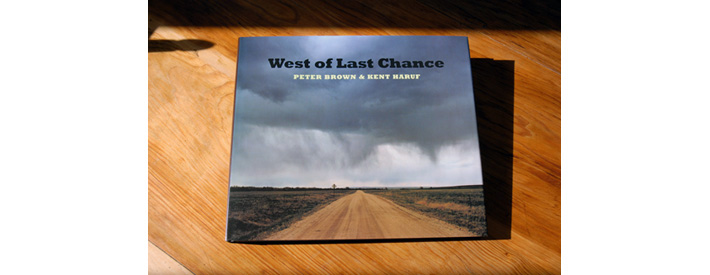
West of Last Chance
256 pages
W.W. Norton & Co., 2008
Available on Amazon.com
Contact Peter Brown for signed copies.
West of Last Chance is a collaboration with the novelist Kent Haruf - his words, my photographs. Kent wrote the novel Plainsong, which was nominated for the National Book Award in 1999, the equally well received Eventide which was published three years later, and two other novels - Where You Once Belonged and The Tie That Binds, the latter of which won the Whiting Prize. Kent is a good friend and we worked together easily on West of Last Chance. Our work was funded by the Dorothea Lange - Paul Taylor Prize from the Center for Documentary Studies at Duke University and the book went on to be excerpted in a number of magazines.
In one of his early entries in the book Kent Haruf writes of the High Plains: “You have to know how to look at this country. You have to slow down. It isn’t pretty, but it’s beautiful."
"I first met Peter at the Brazos Bookstore in Houston in the fall of 1999. It was there he gave me a copy of his book of photographs On the Plains, and I was so taken by the beauty and clarity of the photographs that I asked my publisher to hire him to take a photograph for the cover of my next book. They did—and we went out onto the High Plains together, where he made a beautiful image of a little town at dusk in northeastern Colorado while I stood around watching him work. That was the beginning of our close friendship and the start of our collaboration on this book. We each knew what we wanted, what we hoped for, in a book of photographs and prose about the High Plains from the day we first started talking about it. We wanted to present a view of the plains, in a manner and a form, that had not been done before. We set about working on the book separately: I wrote a number of short pieces; Peter made more of his beautiful photographs. Then we met in Limon, Colorado, and ranged out from there—driving across the great flat treeless country, looking at the open pastures and the wide stretches of farmland, driving around in the familiar little towns, turning onto the main streets and heading up the back alleys, talking to people and listening to them, and always looking at the way the light fell on everything, seeing again and again how everything stood up so precisely and cast such shadows in that clear light. We met for a number of days in that way, at varying seasons of the year, and Peter spent many days on his own, working out in the country with his big camera. During this period of planning and collaboration we talked on the phone fifty times and wrote back and forth any number of times, and gradually we arrived at an ordering of the prose and the photographs that we believed was both logical and evocative—arriving at a book, we hoped, that would show as clearly as we felt it our deep and abiding, unsentimental affection for the High Plains and its various people—out of the years of our experience of this exact place in America and out of the hours of our thought and our wonder about it." - Kent Haruf
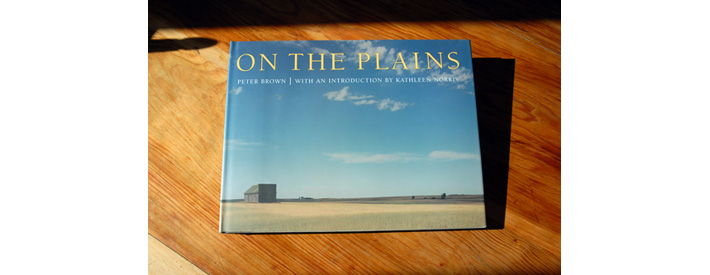
On the Plains
131 pages
W.W. Norton & Co., 1999
Available on Amazon.com
Contact Peter Brown for signed copies.
From Peter Brown:
On the Plains is a book about the cultural landscape of the High Plains. Essentially, it is a book about a trip to town. The photographs begin in open country (drawn from a variety of locations), move to a very small town (made up of many), work their way on to a larger town (again from many) and finally end where they began, in open space and sky.
I worked on this simple idea for more than twelve years, using a large format camera with color film, and gradually a group of pictures from Texas, the western parts of Oklahoma, Kansas, Nebraska and the Dakotas, and the eastern parts of Montana, Wyoming, Colorado and New Mexico began to emerge. The idea was to describe the look, the feel and the cultural content of the contemporary Plains: the stark but subtle beauty of the open country (its space, color, light and weather), the uses to which the land has been put, and the quiet but intense mix of small town life.
I wanted to describe this country simply and clearly, with an eye out for images that expanded as they were considered.
There is great beauty on the Plains, often a problematic relationship to the land, and a complex array of American myths that have played themselves out. Kathleen Norris, (Dakota: A Spiritual Geography, The Cloister Walk, Amazing Grace) a writer who lived for many years in Lemmon, South Dakota, wrote an introduction to the book, and her essay lines out some of the implications of my photographs.
An excerpt from the book published in DoubleTake won the Alfred Eisenstaedt Award in 1999, and the book went on to win the Fred Whitehead Award for design from The Texas Institute for Letters. Molly Renda was the designer.
For further explanation of my thought and process - look under Writing on this website for my Afterword to On the Plains.
From Alexa Dilworth of the Center for Documentary Studies at Duke University:
"When Peter Brown moved to Texas, he had driven through American’s western Plains many times, but for him, as for most Americans, it was an unknown region, passed through on the way to somewhere else. As he began to photograph this remarkable landscape, he started a journey that would take him over a dozen years and many thousand miles to complete. Brown’s photographs make a careful study of the West’s land and sky and of the people who inhabit its towns and cities, showing us the endless variations of color, light, mood, and character that can be found there. In Brown’s portraits we see the Plains in all their seasons, an every-changing landscape of extremes, where weather is a genuine presence and human existence is fragile but resilient. These provocative images reveal both the drama and subtle charms of the land and the people of this vast swath of America."
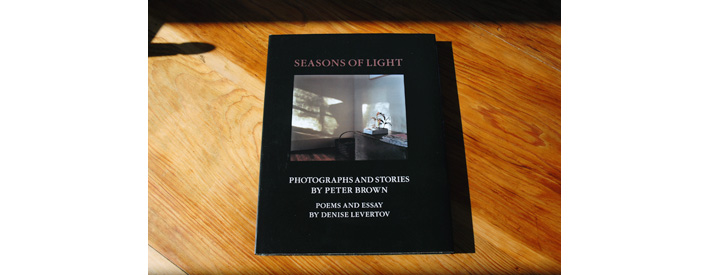 Seasons of Light133 pages
Seasons of Light133 pages
Rice University Press, 1988
Available on Amazon.com
Contact Peter Brown for signed copies.
From Peter Brown:
Seasons of Light was first a boxed portfolio of twenty dye transfer prints and twenty letter press printed texts. It was made at the Stanford University Art Department Press in 1982. The letterpress was done by Leo Holub, my teacher at Stanford and a master letter press printer, and by Ann Rosener who designed the portfolio. 801 Editions in Houston (Owen Wilson, Paul Judice and Dennis Ivey) made the dye transfer prints. The portfolio was published in 1982, won the Imogen Cunningham Award and was excerpted in a number of magazines.
The book Seasons of Light was published by the Rice University Press six years later with an essay by the poet Denise Levertov. The book was expanded from the original portfolio and included twenty-eight images along with accompanying texts. Levertov wrote five original poems, spin-offs as she called them, and these were included in the book in addition to her essay.
Leo Holub’s introduction to Seasons of Light (the portfolio):
"This portfolio, twenty brilliant photographs in color and a score of matching stories, a joyful mix of mind and eye, is a first edition by the young American photographer/writer/teacher Peter Brown.
The photographs, charged with quiet emotion, collected in the still moments of Peter’s various travels, are not about scene or moment or even about subject matter; they are about space and time – time past and time not yet arrived – and about a pervading quality of light which illuminates his every environment.
Viewed singly, each image is self-sufficient: taut, lush and complete. In small groupings or in its entirety, the work expands to reflect the consistent vision of the artist and exhibits an agreeable harmony. While the photography has its own unity and is sufficient unto itself, for Peter there was more to be told, so we have a story to go with each image; not a literal exposition as you will see, but jottings of the mind as he studied what he and the lens had captured.
From early recollections, from learned wisdom, from persistent memory (and its vagaries), from dreams, from fantasy, from the jet stream of the subconscious Peter has woven his fables so directly and so tightly they ring of ultimate truth.
In these vignettes, some remembered with unerring accuracy, others formed from shards of memory lovingly but improperly reassembled, he has let us peer into his intimate being; in his soul we see mirrored some of our own lives and emotions, and our bonds to each other.
Books have long been done combining picture and word, but more often than not they become uneasy companions. Peter’s images and words have the integrity of a common source: the same brilliant light, which is the source of each photograph, also illuminates the writing."